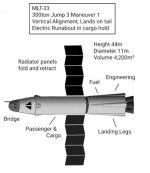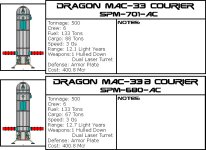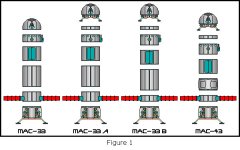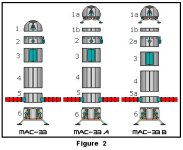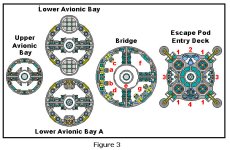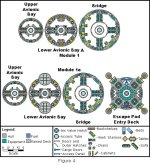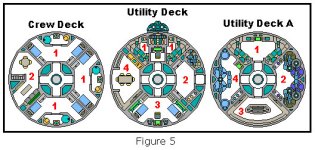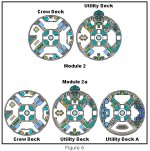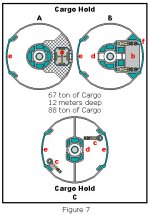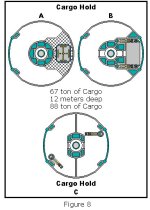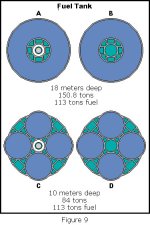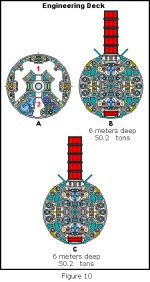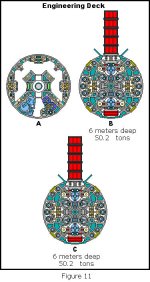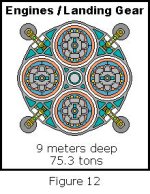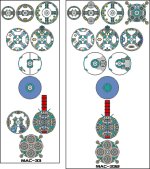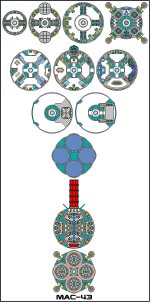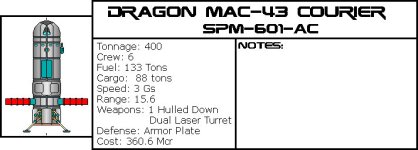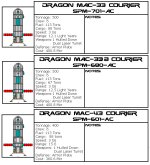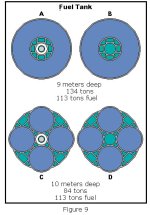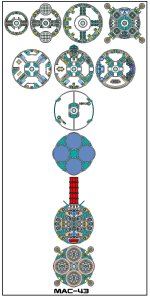Incoming Transmission: Wall of Text Warning, inbound! You have been Warned!
Introduction:
Welcome to my little TED Talk I call COTI Build 2: Dragon MAC-33. I decided, since the original thread is buried in COTI File Library, (file link here: ( www.travellerrpg.com/index.php?threads/the-coti-build.22557/ ) I'd refresh everybody's memories and add some more detail on my way of building Starships. How you can generate a back story for the ship. What influences me during the construction and design phase. And lucky for @Dragoner, he got 2 ships for the price of 1, Just by tweaking the design.
Background:
Conversation in the following two threads on the COTI Forum; 'Where are the Image Libraries?' and 'Drawing Ships.' got me thinking about how I build a ship on a personal level. Then @Dragoner and I had a bit of back and forth and I decide to build my own version of his 'Andromeda Dragon' based off his design. So I decided to use this ancient format to present my design for Dragoner's wonderful ship because, a PDF wasn't going to cut it for me (You'll see why as we get into this.)
First off a little history lesson on Tech Levels I use:
Industrial: From the 1700s through to near future. We are either in Middle or High Industrial at present. Hylox is the main fuel source for the reaction engines in use. Solar power is commonly used on spacecraft. Atomic Power starts to be used Mid to Late Industrial Period.
Interplanetary: When mankind permanently colonizes other worlds within the solar system. This period could last a hundred years to a thousand years depending on if they decide to us C-Drives to travel the vast distance between Star System or when they discover Jump Drives. Atomic Power is the main source of power, and later (Late Period) Fusion Reactors become common at this time. Main drive systems are HEPRE and Particle drives, Gravitronics along with Jump Drives, come in to play towards the end of the period.
Prestellar: This period could last a hundred years to a thousand years. Colonize of nearby solar systems occurs. By the middle of the period trade, travel and further colonization have become common. Fusion Reactor replaces Atomic Power completely. HEPRE drives are phased out. Gravitronics start to become common place around the Middle of this period. Particle Drives are still common. Electrostatic Drives (ED) technology is discovered. (Note: ED simply put, are energy in, thrust out. No need for fuel, just the power off your reactor.
Stellar: The world of Traveller starting at about Tech Level 12.
This is the simplest I can make it.
SO, Tail-Sitter start in the Middle Industrial Period and basically start to being phased out in the Early Prestellar Period. The reason I say this is, Gravitronics and Electrostatic Drives allowing for ships like the Standard Scout and Far Trader to be easily built. Gravitronics especially allow for larger ships to be built and allows them to land on planetary surfaces much safer.
Design Choices and Influences:
Therefore, Tail-Sitters are cramped because they need to save space and weight. They usually use Atomic Reactors which makes the rear of the ship hazard to mankind. Particle Drives are the safest drives during the periods, as I have already discussed. Around the Late-Interplanetary, they are powerful enough to land on planets with 1 Gs and below. HEPRE are very dangerous because they spew highly radioactive material out of there thrust nozzle but because they a hybrid reactor (Using fuel to cool the reactor and expelling as thrust.) you don't need a reactor at all. However, ecosystems are endangered by these engines if, they try to land. So they are regulated to exploring and charting space during the High-Interplanetary and Early-Prestellar. With this in mind, here are the assumptions I made about Dragoner design.
1: The reactor is atomic.
2: The fuel is used for the Particle Drives.
3: Because of what Dragoner said in the thread, I take it, his campaign is based right at end of the Prestellar Period or at the beginning of Stellar Period. I know the craft was built to Tech Level 12 so the drive system could be Electrostatic. So, I've given you two ships with two different Tech Level's to play with.
Therefore, Tail-Sitters are cramped, the rear of the ship might be highly radioactive (depends on Tech Level) and it is a throwback to a pervious era when designs were way less complicate. I also like 1950's and early 60's designs for these ships. It the vibe I get and seems natural in the progress of the technology.
Comparison:
So we are now at the point where we take a look at his ship (full deck plans in 'Drawing Ships ' and he gave me the Cepheus stats as well.
His stats in my MTU:
'Andromeda Dragon'
SPM-484-AT
Tonnage: 300
Crew: 4, 2 mission specialist or 2 passengers
Fuel: 110 tons
Cargo: 74 tons
Speed: 3Gs
Range: 17 Light Years
Weapons: Turret mounted Laser, Missiles and Sandcasters (ship has magazine as well.).
Defense: (assuming) Armor Plate
Cost: 290.4 MCR
This is me converting Traveller stats into MTU.
As you can see from these Data Plates for my ships, My ships are larger Tonnage wise than those built to Traveller Spec. I design using my homebrewed systems. The major changes in the stats are to the Tonnage, and Range.
Tonnage: This is because I draw them first before I figure out the Tonnage. I use a 1.5 meter square as the basis for my Deckplans. Using (1.5x1.5x3)x2 = 13.5 m per ton. I found a nice cylindrical math calculator online. It gives me the meters and I divide by 13.5 to get the Tonnage. I also use the Traveller rule about it being within 20% of the Hull Tonnage (example: 100 ton Hull +/- 20 Tons missing from Deckplans, "Meh..it's all good."
I use 1 light year traveled per day, I had player running off the maps and systems I created using Jump Drives, and had to wing it until I did 1 light year thing. Hyperspace Generators produce the FTL in MTU and Jump means several different thing as well, including Jump Drives (That's for another times).
Range: In the Case of the 'Andromeda Dragon', because of its fuel load translates poorly into my system and smaller size of the ship have a longer range (3.25 Light years x Jump -3 = 9.75 Range) than it should have.
Three formulas are used to determine the range of a ship.
For Electrostatic Drives: Fuel Tons x 83/displacement/# of reactors = Range
For Particle/HEPRE Engines: Fuel Tons x 75/displacement/# of reactors = Range
For Hylox: Fuel Tons x 45/displacement/# of engines = Range
The displacement is Tonnage+Fuel+Cargo.
(Additions items are: Launches, drop tanks, cargo pods anything that either mounts to the ship or very large items which require its own room. This room will be counted like cargo space if it is for vehicles and seen as dual purpose.)
Default for reactors (power plants using fuel) is one. (Yes, this is changed from the old thread. I saw how 'BIG' fuel loads were going to be and scrapped it. Hylox needs reworked as well.)
'Andromeda Dragon'=484
Dragon MAC-33=701
Dragon MAC-33A=680
The math is as follows:
'Andromeda Dragon' is: 100x75/484/1=17 Light Years
Dragon MAC-33 is: 113x75/701/1=12.08 Light Years (rounded up 12.1 Light Years)
Dragon MAC-33B is within that 20% rule so I didn't change it.
Game Mechanics and other things:
SO what does this mean for travel in my universe. Well it goes something like this: You spend one day Taking Off and Leaving the system then, at the other end you reverse that. This reduces the Range by 2 light years. Combat encounters also reduces your range by 1, stop in between destination as well. I've done the math using all sorts of tables, brought in ideas from other game systems and you get some wild times just using travel to orbit, and travel to Jump Distance. Add in an encounter, intersystem travel, refueling off a gas giant and the times are all over the place. So I simplified it.
Using this system the Dragon Mac-33 can travel for 10.7 from one planet to the next without stopping, that awful close to 3 parsecs or 9.75 light years. My system doesn't import Traveller Designs very well unless I play with the fuel load. If you're wondering about reactors, they supply 30 days of power regardless if you burn through your Range. Dragon Mac-33 B max range is 12 Light Years
The maneuvering drives just add weight. However I have two rules: 1. If it looks fast the Drives are going to be fast. 2. Other ships, number of drives usually mean; For Interplanetary 1gs per drive, 1gs to1.5gs at Prestellar and at Stellar 1.5gs to 2gs and so on. Of course, I do play round with Gs when I'm building something for Traveller or the design calls for it.
Depiction or Artistic License:
The larger something is, the more power it is. Off the top of my head, I can use 30 different depictions of Drives in my many drawings. Sometimes, the size 'fits' the design artistically, other times it's to scale.
A perfect example of this are the beds in my staterooms, they're real close to being 1.5m x 2m in dimensions. They are just a depiction of what is in the room, nothing more. My Smallest Stateroom is 5.25 meters by 3.75 by 3 meters which equals 4.4 tons. In that depiction, the bed takes most of the free space up in the area of 3mx3.75m (12by10 feet) room. Hell, that's a small bedroom in a house. Room enough for a chair and dresser, maybe even a desk? But all I've depicted is the bed. And it's all because if, I make the bed to scale, it looks really bad (Being nice with my words here.). That were Artistic License comes in.
The designs I use to depict something a ship are only there to say. "Hey, I'm in the Mess Hall" or "This is your Stateroom." They only tell you the function and not the actual details inside the room. I've made a point to standardize these rooms so they really mean something in the Deckplans. You can go ship to ship and see the same depiction for the same room in each ship. However, it's up to the GM or the Player to fill in description of that room. Not me, but the people playing the game. One last thing I'd like to point out, the corridors and hallways I show on many of my ships is only 1.6 meters or 5' 3" feet wide.
Now onto the Build:
General Notes about the Ship:
In case of emergency, the Access Tube can be closed off by a hatch in the floor and ceiling. This can be done either manually or from the bridge. In case of a hull breach, room doors act as temporary airlocks preventing atmosphere from escaping from the entire ship.
All pressurized and normal hatches (including bay doors) are locked and alarmed by a Security System. They are monitored by a Surveillance System which can be monitored from the bridge. The Surveillance also monitors all passages, rooms and key equipment areas (such as the Engineering deck and key equipment throughout the ship.) Hatches and doors can be locked or unlocked from a panel outside the room or from the Bridge.
Lighting and power on each deck is controlled by a panel built into the Central Trunk. If these are shut off, then the deck is totally dark and all systems on that deck are shut down. The only time this happens is when a major power system on that deck is shut down for repairs or in an emergency. Individual room can be shut down as well from this panel so systems in that room can be worked on. Lighting is controlled by a switch in each room.
The top three Decks of the ship is an Emergency Escape Pod. All is computers, communication, life support and power systems are adequate for 7 days for the entire crew. The bridge can be locked down and its systems can be separated from the ship, effectively isolating it from the rest of the ship. Further, this section has 4 small chemical rockets which can launch the bridge 1000 meters into the air before it comes crashing down 500 meters from the ship when on a planet. While in space, it will act as an Escape Pod or Lifeboat. If this Module separates from the ship. there is no way for the ship to take off again from a planet or the rest of the hull to be reused.
This is why this ship is so interesting to me. There are 6 ships in this class. Two deal with cargo tonnage (67 or 88 tons) alone. The other 4 deal with the way they are layout internally.
This shows the complexity of these plans. There are 10 components shown here (Maybe 11 or more before I finish writing this ). By mixing different layouts, you could make 6+ different ships. I'm only showing 3 because, I don't think Naval planners would go backwards after installing escape pods on these ships. However, there could be a civilian version of the MAC-33 B out there that does not have an Escape Pod?
). By mixing different layouts, you could make 6+ different ships. I'm only showing 3 because, I don't think Naval planners would go backwards after installing escape pods on these ships. However, there could be a civilian version of the MAC-33 B out there that does not have an Escape Pod?
In Figure 2, I have given each areas a number (or Module). The description of each component or module, I'm using in this build.
1 Bridge
1a Escape Pod
1b Locking Ring
2 Crew Quarters
2b Crew Quarters A
3 Cargo Hold
4 Fuel Tank
5 Engineering Deck
5a Reactor
6 Engines/Landing Gear
I will present the deck plans in such an order to show these areas and how a simple change in either order or design of the decks you can have several designs to use in your game.
1: Bridge
Upper Avionic Bay
Description: These two bays houses the navigational radar, computers and sensor necessary for flight in space. There is also a distress beacon which will active as soon as the Escape Capsule is fired. It will only broadcast for 7 days, the length of the power generator. This deck should be treated as a half-deck with a high center that tampers off towards the outer edges.
Lower Avionic Bay
Description: These two bays houses the equipment necessary for the avionics to communicate with the Bridge. There are 2 parachutes (top and Bottom) used if the Escape Pod attempts to land on a planet. There are four Directional Motors on this deck as well which helps the ship maneuver. This deck is treated as a full height deck.
Lower Avionic Bay A
Description: These two bays houses the equipment necessary for the avionics to communicate with the Bridge. The 2 parachutes have been removed. this deck replaces Avionics Bay Lower Deck if you intend not to have an escape pod on this ship. There are four Directional Motors on this deck as well which helps the ship maneuver. This deck is treated as a full height deck.
NOTE: The decks of the rest of the ship are full height decks unless stated.
Bridge
Description: The Bridge is the command and control center of the ship. All stations are connected by intercoms.
a Pilot's Station: This station is used to control the ship during flight operations.
b Co-pilot's Station: Same as Pilot's Station.
c Captain's Chair: From this workstation, the Captain monitors all ship's activities. He also controls the surveillance system, is able to lock and unlock hatches and the door, and is the only one able to launch the escape capsule. His station is password protected due to security and privacy concerns.
d Engineering Console: monitors all ship's functions as well as equipment. It controls and monitors the power grid, life support and essential systems
e Security Area: This area provides an extra level of security for the bridge. Both hatches in this area are using a security locks.
f Computer Room: This room contains the ship's central computer, which handles all flight information, and data needs for the ship. Access to this room restricted.
g Engineering Room: This room is used by two engineers to monitor the ship during daily operations.
Escape Pod Entry Deck
Description: To the players this is an access tube between the Crew Quarters and Bridge. It can be sealed off by two Iris Valve Hatches one located in the roof of the Crew Quarters deck and the other in the floor of the Bridge. The Tube is lined with access panels. It can also be used as a temporary airlock if the ship has lost its atmosphere or is separated from the ship.
Mooring clamps and explosive bolts hold this deck in place hidden behind Locking Ring 1b. The escape capsule is launched from the Captain's station on the Bridge It is the last resort at his disposal to save the crew. Once the capsule leaves the ship, it can't be returned to the ship or be reattached.
The Bridge is normally sealed off from the rest of the ship during Jumps. Emergencies which the Captain may seal off the bridge are: The ship is being boarded by a hostile force, contamination by an alien organism, or lots of atmosphere.
1 Landing Gear/Solid Fuel Rockets: There are 4 rockets on this deck. They provide enough thrust for capsule to move away from the ship in a grave emergency. The power these rockets generate was never intended to launch the capsule into space. The landing gear provides the necessary clearance for personnel to leave after it has landed on a solid surface.
2 Atmospheric Scrubbers: These scrubbers are only intended to clean the Bridge's air supply for 7 days, if it has been sealed off or separated from the ship
3 Electronics' Bay: The electronics in these areas allow the Bridge's controls to communicate with the rest of the ship and feed information to workstations located there.
4 Power Generator: Provides power to the Bridge for 7 days or if, it has been sealed off to protect the crew or separated from the ship.
Module 1
So to create a Bridge module, you would use: Avionic Bay Upper Deck, Avionic Bay Lower Deck A, and Bridge.
Module 1a
To create an Escape Pod, you would use: Avionic Bay Upper Deck, Avionic Bay Lower Deck, Bridge and Escape Pod Entrance Deck.
2. Crew Deck:
Crew Deck
Description: This deck contains the 3 Double Occupancy Staterooms and Ships Lounge.
1 Stateroom: Each room has 2 single bunks, 2 wall lockers, additional storage above and below the bunks and bathroom with shower.
2 Ship's Lounge: This is the room where the gather off duty to watch some vids, swap stories and play cards. The room basically divided into 2 by a short wall in the center at the top of the room. Also in this area is a small round table which can seat 4. At the bottom is a couch, coffee table and directly in front of that is a flat screen media player.
Utility Deck
Description: This deck house several room that pertain to the safety and well being of the crew.
1 Hulled Down Dual Laser Cannon Turret: A Hulled Down Turret simply means the gunner is within the hull of the ship and not sitting in the turret like in a tank. The turret is mounted to the hull and contains only 2 laser cannons and the targeting systems for the cannons. The control this turret by a console in this room.
2 Airlock: The airlock allows access to the interior of the ship. The cabinet in the room houses tools, safety equipment used during spacewalks, space suits, EVA equipment and the airlock control panel. The only other way to enter the ship is through the cargo hold. All personal must pass through this room during space travel.
3 First Aid Station: This is simply a first aid station for the ship. It contains 2 life support beds and several supply lockers and cabinet mounted on the walls. A small workstation is provided to allow the Med Tech to monitor patients. A single workstation allows a medic to scan an individual lying on the Med Bed. It cannot diagnose diseases or illness. It only aids the medic in their treatment of an injured or sick Crewman.
4 Galley: The dining area seating for 6. It has a full kitchen which is located at the top of the room. At the bottom, there is a storage area for food supplies.
Utility Deck A
Description: This deck was designed to get rid of the Engineering Deck and provide a safer environment for the crew. It also cuts down on unnecessary pipes and duct work used by the Life Support System by placing the Water Purification Plant and Atmospheric Scrubbers close to the main living area of the ship.
1 Remote Controls for the Reactor: This room houses the equipment that monitors and controls the reactor. It is networked with the stations provided in Room g. The only purpose of this room is to monitor and control the reactor. You cannot control any other system for this room. The reactor can be manually shut down from this level.
2 Water Purification Plant: This unit cleans and sanitizes the water during its mission. Water brought in from the planet surface can be filtered as well. Filters can be changed and cleaned by the ship's crew if, they have them in the ship's stores. Otherwise, recharging this unit can only be done at a spaceport.
3 Ship Stores: This storage room contains most of the spares parts need for repair, some person storage, weapons and ammo and additional food supplies. It may also be used to store the mail.
4 Atmospheric Scrubbers: This maintains the ship's atmosphere for 30 days or 720 hours. Once on the planet's surface, the system cleans the air coming into the ship. Filters can be changed and cleaned by the ship's crew if, they have them in the ship's stores. Otherwise, recharging this unit can only be done at a spaceport.
NOTE: If you are planning to use the Engineering Deck, then Utility Deck A is not necessary to the Deckplans. It is a Design Choice I made, because of what I wrote in the Description of this deck. And a simple concept most people who design deckplans overlook. If the reactor breaks down or is damaged, how in the Heck are 6 people going to carry out the repair? Forget this puppy might be atomic power, who in their right mind carries major parts for a reactor on their ship? A Hammer, Duct Tape, Bailing Wire and Glue, just are not going to cut it, boys!
Module 2
To create Module 2 you will need Crew Deck and Utility Deck. This Module is used if you are planning to use Engineering.
Module 2a
If you are not planning to use Engineering Deck, then use this set. Crew Deck, Utility Deck and Utility Deck A.
3 Cargo Hold
General Information: The Cargo Deck is 12 meter depth and 12 meters in diameter. The views present are from a top down perspective. Since technically cargo can be mounted on the floor, ceiling and floor of this bay, Tying down the cargo is very important, unless you wish to have a 1 ton crate come crashing down from the ceiling because it was not secured correct, once normal gravity returns. The 3D environment means there is a robot arm mounted to a track at the top of Cargo Hold (Not shown). Which gives it full access to the entire Hold and it could also help load cargo from the outside in zero-g environments. The entrance to this deck is always going to be at the lowest level (d). Also important to understand, the amount of cargo will vary between the 2 designs.
Cargo Hold A-B
Description: Deck A show the upper 2/3 of the deck, while Deck B shows the lower 1/3 of the deck. Deck B is intended to show the room which contains airlock and pallet hoist (b). The pallet hoist is loaded through a hatch (a) show in Deck A atop of the Airlock's outer casing. The design allows the main cargo bay doors (e) to remain closed in caustic environment or inclement weather. The pallet hoist is more stable than to single jib cranes (c) on Deck C. The pallet can carry 3 Tons per lift. The Cargo Hatch for the Airlock is 2.8 meters in height by 7.4 meters wide (f), while main Cargo Bay Door is 10.8 meters in height by 7.4 meters wide(e). The amount of cargo this configuration can carry is 67 Tons.
Cargo Hold C
Descriptions: Deck C shows 2 Cargo Bay Door is 10.8 meters in height by 7.4 meters wide(e) but, the location of the Jib Cane reduces the largest object to fit through the opening to 5.6 Meters wide by 10.8 Meters High. The Deck is divided in two to protect the cargo. The design allows the main cargo bay doors (e) in one hold to remain closed in caustic environment or inclement weather. These large items are only load and unloaded by highly trained professions with external machines or Grav Lifting Equipment. The Jib Cranes (c) can only handle cargo up to 1 Ton per lift. The amount of cargo this configuration can carry is 88 Tons
Module 3
Module 3 is either Cargo Deck A-B or Cargo Deck C. It cannot be both without major overhaul of the information on the Data Plates.
Introduction:
Welcome to my little TED Talk I call COTI Build 2: Dragon MAC-33. I decided, since the original thread is buried in COTI File Library, (file link here: ( www.travellerrpg.com/index.php?threads/the-coti-build.22557/ ) I'd refresh everybody's memories and add some more detail on my way of building Starships. How you can generate a back story for the ship. What influences me during the construction and design phase. And lucky for @Dragoner, he got 2 ships for the price of 1, Just by tweaking the design.
Background:
Conversation in the following two threads on the COTI Forum; 'Where are the Image Libraries?' and 'Drawing Ships.' got me thinking about how I build a ship on a personal level. Then @Dragoner and I had a bit of back and forth and I decide to build my own version of his 'Andromeda Dragon' based off his design. So I decided to use this ancient format to present my design for Dragoner's wonderful ship because, a PDF wasn't going to cut it for me (You'll see why as we get into this.)
First off a little history lesson on Tech Levels I use:
Industrial: From the 1700s through to near future. We are either in Middle or High Industrial at present. Hylox is the main fuel source for the reaction engines in use. Solar power is commonly used on spacecraft. Atomic Power starts to be used Mid to Late Industrial Period.
Interplanetary: When mankind permanently colonizes other worlds within the solar system. This period could last a hundred years to a thousand years depending on if they decide to us C-Drives to travel the vast distance between Star System or when they discover Jump Drives. Atomic Power is the main source of power, and later (Late Period) Fusion Reactors become common at this time. Main drive systems are HEPRE and Particle drives, Gravitronics along with Jump Drives, come in to play towards the end of the period.
Prestellar: This period could last a hundred years to a thousand years. Colonize of nearby solar systems occurs. By the middle of the period trade, travel and further colonization have become common. Fusion Reactor replaces Atomic Power completely. HEPRE drives are phased out. Gravitronics start to become common place around the Middle of this period. Particle Drives are still common. Electrostatic Drives (ED) technology is discovered. (Note: ED simply put, are energy in, thrust out. No need for fuel, just the power off your reactor.
Stellar: The world of Traveller starting at about Tech Level 12.
This is the simplest I can make it.
SO, Tail-Sitter start in the Middle Industrial Period and basically start to being phased out in the Early Prestellar Period. The reason I say this is, Gravitronics and Electrostatic Drives allowing for ships like the Standard Scout and Far Trader to be easily built. Gravitronics especially allow for larger ships to be built and allows them to land on planetary surfaces much safer.
Design Choices and Influences:
Therefore, Tail-Sitters are cramped because they need to save space and weight. They usually use Atomic Reactors which makes the rear of the ship hazard to mankind. Particle Drives are the safest drives during the periods, as I have already discussed. Around the Late-Interplanetary, they are powerful enough to land on planets with 1 Gs and below. HEPRE are very dangerous because they spew highly radioactive material out of there thrust nozzle but because they a hybrid reactor (Using fuel to cool the reactor and expelling as thrust.) you don't need a reactor at all. However, ecosystems are endangered by these engines if, they try to land. So they are regulated to exploring and charting space during the High-Interplanetary and Early-Prestellar. With this in mind, here are the assumptions I made about Dragoner design.
1: The reactor is atomic.
2: The fuel is used for the Particle Drives.
3: Because of what Dragoner said in the thread, I take it, his campaign is based right at end of the Prestellar Period or at the beginning of Stellar Period. I know the craft was built to Tech Level 12 so the drive system could be Electrostatic. So, I've given you two ships with two different Tech Level's to play with.
Therefore, Tail-Sitters are cramped, the rear of the ship might be highly radioactive (depends on Tech Level) and it is a throwback to a pervious era when designs were way less complicate. I also like 1950's and early 60's designs for these ships. It the vibe I get and seems natural in the progress of the technology.
Comparison:
So we are now at the point where we take a look at his ship (full deck plans in 'Drawing Ships ' and he gave me the Cepheus stats as well.
His stats in my MTU:
'Andromeda Dragon'
SPM-484-AT
Tonnage: 300
Crew: 4, 2 mission specialist or 2 passengers
Fuel: 110 tons
Cargo: 74 tons
Speed: 3Gs
Range: 17 Light Years
Weapons: Turret mounted Laser, Missiles and Sandcasters (ship has magazine as well.).
Defense: (assuming) Armor Plate
Cost: 290.4 MCR
This is me converting Traveller stats into MTU.
As you can see from these Data Plates for my ships, My ships are larger Tonnage wise than those built to Traveller Spec. I design using my homebrewed systems. The major changes in the stats are to the Tonnage, and Range.
Tonnage: This is because I draw them first before I figure out the Tonnage. I use a 1.5 meter square as the basis for my Deckplans. Using (1.5x1.5x3)x2 = 13.5 m per ton. I found a nice cylindrical math calculator online. It gives me the meters and I divide by 13.5 to get the Tonnage. I also use the Traveller rule about it being within 20% of the Hull Tonnage (example: 100 ton Hull +/- 20 Tons missing from Deckplans, "Meh..it's all good."
I use 1 light year traveled per day, I had player running off the maps and systems I created using Jump Drives, and had to wing it until I did 1 light year thing. Hyperspace Generators produce the FTL in MTU and Jump means several different thing as well, including Jump Drives (That's for another times).
Range: In the Case of the 'Andromeda Dragon', because of its fuel load translates poorly into my system and smaller size of the ship have a longer range (3.25 Light years x Jump -3 = 9.75 Range) than it should have.
Three formulas are used to determine the range of a ship.
For Electrostatic Drives: Fuel Tons x 83/displacement/# of reactors = Range
For Particle/HEPRE Engines: Fuel Tons x 75/displacement/# of reactors = Range
For Hylox: Fuel Tons x 45/displacement/# of engines = Range
The displacement is Tonnage+Fuel+Cargo.
(Additions items are: Launches, drop tanks, cargo pods anything that either mounts to the ship or very large items which require its own room. This room will be counted like cargo space if it is for vehicles and seen as dual purpose.)
Default for reactors (power plants using fuel) is one. (Yes, this is changed from the old thread. I saw how 'BIG' fuel loads were going to be and scrapped it. Hylox needs reworked as well.)
'Andromeda Dragon'=484
Dragon MAC-33=701
Dragon MAC-33A=680
The math is as follows:
'Andromeda Dragon' is: 100x75/484/1=17 Light Years
Dragon MAC-33 is: 113x75/701/1=12.08 Light Years (rounded up 12.1 Light Years)
Dragon MAC-33B is within that 20% rule so I didn't change it.
Game Mechanics and other things:
SO what does this mean for travel in my universe. Well it goes something like this: You spend one day Taking Off and Leaving the system then, at the other end you reverse that. This reduces the Range by 2 light years. Combat encounters also reduces your range by 1, stop in between destination as well. I've done the math using all sorts of tables, brought in ideas from other game systems and you get some wild times just using travel to orbit, and travel to Jump Distance. Add in an encounter, intersystem travel, refueling off a gas giant and the times are all over the place. So I simplified it.
Using this system the Dragon Mac-33 can travel for 10.7 from one planet to the next without stopping, that awful close to 3 parsecs or 9.75 light years. My system doesn't import Traveller Designs very well unless I play with the fuel load. If you're wondering about reactors, they supply 30 days of power regardless if you burn through your Range. Dragon Mac-33 B max range is 12 Light Years
The maneuvering drives just add weight. However I have two rules: 1. If it looks fast the Drives are going to be fast. 2. Other ships, number of drives usually mean; For Interplanetary 1gs per drive, 1gs to1.5gs at Prestellar and at Stellar 1.5gs to 2gs and so on. Of course, I do play round with Gs when I'm building something for Traveller or the design calls for it.
Depiction or Artistic License:
The larger something is, the more power it is. Off the top of my head, I can use 30 different depictions of Drives in my many drawings. Sometimes, the size 'fits' the design artistically, other times it's to scale.
A perfect example of this are the beds in my staterooms, they're real close to being 1.5m x 2m in dimensions. They are just a depiction of what is in the room, nothing more. My Smallest Stateroom is 5.25 meters by 3.75 by 3 meters which equals 4.4 tons. In that depiction, the bed takes most of the free space up in the area of 3mx3.75m (12by10 feet) room. Hell, that's a small bedroom in a house. Room enough for a chair and dresser, maybe even a desk? But all I've depicted is the bed. And it's all because if, I make the bed to scale, it looks really bad (Being nice with my words here.). That were Artistic License comes in.
The designs I use to depict something a ship are only there to say. "Hey, I'm in the Mess Hall" or "This is your Stateroom." They only tell you the function and not the actual details inside the room. I've made a point to standardize these rooms so they really mean something in the Deckplans. You can go ship to ship and see the same depiction for the same room in each ship. However, it's up to the GM or the Player to fill in description of that room. Not me, but the people playing the game. One last thing I'd like to point out, the corridors and hallways I show on many of my ships is only 1.6 meters or 5' 3" feet wide.
Now onto the Build:
General Notes about the Ship:
In case of emergency, the Access Tube can be closed off by a hatch in the floor and ceiling. This can be done either manually or from the bridge. In case of a hull breach, room doors act as temporary airlocks preventing atmosphere from escaping from the entire ship.
All pressurized and normal hatches (including bay doors) are locked and alarmed by a Security System. They are monitored by a Surveillance System which can be monitored from the bridge. The Surveillance also monitors all passages, rooms and key equipment areas (such as the Engineering deck and key equipment throughout the ship.) Hatches and doors can be locked or unlocked from a panel outside the room or from the Bridge.
Lighting and power on each deck is controlled by a panel built into the Central Trunk. If these are shut off, then the deck is totally dark and all systems on that deck are shut down. The only time this happens is when a major power system on that deck is shut down for repairs or in an emergency. Individual room can be shut down as well from this panel so systems in that room can be worked on. Lighting is controlled by a switch in each room.
The top three Decks of the ship is an Emergency Escape Pod. All is computers, communication, life support and power systems are adequate for 7 days for the entire crew. The bridge can be locked down and its systems can be separated from the ship, effectively isolating it from the rest of the ship. Further, this section has 4 small chemical rockets which can launch the bridge 1000 meters into the air before it comes crashing down 500 meters from the ship when on a planet. While in space, it will act as an Escape Pod or Lifeboat. If this Module separates from the ship. there is no way for the ship to take off again from a planet or the rest of the hull to be reused.
This is why this ship is so interesting to me. There are 6 ships in this class. Two deal with cargo tonnage (67 or 88 tons) alone. The other 4 deal with the way they are layout internally.
This shows the complexity of these plans. There are 10 components shown here (Maybe 11 or more before I finish writing this
In Figure 2, I have given each areas a number (or Module). The description of each component or module, I'm using in this build.
1 Bridge
1a Escape Pod
1b Locking Ring
2 Crew Quarters
2b Crew Quarters A
3 Cargo Hold
4 Fuel Tank
5 Engineering Deck
5a Reactor
6 Engines/Landing Gear
I will present the deck plans in such an order to show these areas and how a simple change in either order or design of the decks you can have several designs to use in your game.
1: Bridge
Upper Avionic Bay
Description: These two bays houses the navigational radar, computers and sensor necessary for flight in space. There is also a distress beacon which will active as soon as the Escape Capsule is fired. It will only broadcast for 7 days, the length of the power generator. This deck should be treated as a half-deck with a high center that tampers off towards the outer edges.
Lower Avionic Bay
Description: These two bays houses the equipment necessary for the avionics to communicate with the Bridge. There are 2 parachutes (top and Bottom) used if the Escape Pod attempts to land on a planet. There are four Directional Motors on this deck as well which helps the ship maneuver. This deck is treated as a full height deck.
Lower Avionic Bay A
Description: These two bays houses the equipment necessary for the avionics to communicate with the Bridge. The 2 parachutes have been removed. this deck replaces Avionics Bay Lower Deck if you intend not to have an escape pod on this ship. There are four Directional Motors on this deck as well which helps the ship maneuver. This deck is treated as a full height deck.
NOTE: The decks of the rest of the ship are full height decks unless stated.
Bridge
Description: The Bridge is the command and control center of the ship. All stations are connected by intercoms.
a Pilot's Station: This station is used to control the ship during flight operations.
b Co-pilot's Station: Same as Pilot's Station.
c Captain's Chair: From this workstation, the Captain monitors all ship's activities. He also controls the surveillance system, is able to lock and unlock hatches and the door, and is the only one able to launch the escape capsule. His station is password protected due to security and privacy concerns.
d Engineering Console: monitors all ship's functions as well as equipment. It controls and monitors the power grid, life support and essential systems
e Security Area: This area provides an extra level of security for the bridge. Both hatches in this area are using a security locks.
f Computer Room: This room contains the ship's central computer, which handles all flight information, and data needs for the ship. Access to this room restricted.
g Engineering Room: This room is used by two engineers to monitor the ship during daily operations.
Escape Pod Entry Deck
Description: To the players this is an access tube between the Crew Quarters and Bridge. It can be sealed off by two Iris Valve Hatches one located in the roof of the Crew Quarters deck and the other in the floor of the Bridge. The Tube is lined with access panels. It can also be used as a temporary airlock if the ship has lost its atmosphere or is separated from the ship.
Mooring clamps and explosive bolts hold this deck in place hidden behind Locking Ring 1b. The escape capsule is launched from the Captain's station on the Bridge It is the last resort at his disposal to save the crew. Once the capsule leaves the ship, it can't be returned to the ship or be reattached.
The Bridge is normally sealed off from the rest of the ship during Jumps. Emergencies which the Captain may seal off the bridge are: The ship is being boarded by a hostile force, contamination by an alien organism, or lots of atmosphere.
1 Landing Gear/Solid Fuel Rockets: There are 4 rockets on this deck. They provide enough thrust for capsule to move away from the ship in a grave emergency. The power these rockets generate was never intended to launch the capsule into space. The landing gear provides the necessary clearance for personnel to leave after it has landed on a solid surface.
2 Atmospheric Scrubbers: These scrubbers are only intended to clean the Bridge's air supply for 7 days, if it has been sealed off or separated from the ship
3 Electronics' Bay: The electronics in these areas allow the Bridge's controls to communicate with the rest of the ship and feed information to workstations located there.
4 Power Generator: Provides power to the Bridge for 7 days or if, it has been sealed off to protect the crew or separated from the ship.
Module 1
So to create a Bridge module, you would use: Avionic Bay Upper Deck, Avionic Bay Lower Deck A, and Bridge.
Module 1a
To create an Escape Pod, you would use: Avionic Bay Upper Deck, Avionic Bay Lower Deck, Bridge and Escape Pod Entrance Deck.
2. Crew Deck:
Crew Deck
Description: This deck contains the 3 Double Occupancy Staterooms and Ships Lounge.
1 Stateroom: Each room has 2 single bunks, 2 wall lockers, additional storage above and below the bunks and bathroom with shower.
2 Ship's Lounge: This is the room where the gather off duty to watch some vids, swap stories and play cards. The room basically divided into 2 by a short wall in the center at the top of the room. Also in this area is a small round table which can seat 4. At the bottom is a couch, coffee table and directly in front of that is a flat screen media player.
Utility Deck
Description: This deck house several room that pertain to the safety and well being of the crew.
1 Hulled Down Dual Laser Cannon Turret: A Hulled Down Turret simply means the gunner is within the hull of the ship and not sitting in the turret like in a tank. The turret is mounted to the hull and contains only 2 laser cannons and the targeting systems for the cannons. The control this turret by a console in this room.
2 Airlock: The airlock allows access to the interior of the ship. The cabinet in the room houses tools, safety equipment used during spacewalks, space suits, EVA equipment and the airlock control panel. The only other way to enter the ship is through the cargo hold. All personal must pass through this room during space travel.
3 First Aid Station: This is simply a first aid station for the ship. It contains 2 life support beds and several supply lockers and cabinet mounted on the walls. A small workstation is provided to allow the Med Tech to monitor patients. A single workstation allows a medic to scan an individual lying on the Med Bed. It cannot diagnose diseases or illness. It only aids the medic in their treatment of an injured or sick Crewman.
4 Galley: The dining area seating for 6. It has a full kitchen which is located at the top of the room. At the bottom, there is a storage area for food supplies.
Utility Deck A
Description: This deck was designed to get rid of the Engineering Deck and provide a safer environment for the crew. It also cuts down on unnecessary pipes and duct work used by the Life Support System by placing the Water Purification Plant and Atmospheric Scrubbers close to the main living area of the ship.
1 Remote Controls for the Reactor: This room houses the equipment that monitors and controls the reactor. It is networked with the stations provided in Room g. The only purpose of this room is to monitor and control the reactor. You cannot control any other system for this room. The reactor can be manually shut down from this level.
2 Water Purification Plant: This unit cleans and sanitizes the water during its mission. Water brought in from the planet surface can be filtered as well. Filters can be changed and cleaned by the ship's crew if, they have them in the ship's stores. Otherwise, recharging this unit can only be done at a spaceport.
3 Ship Stores: This storage room contains most of the spares parts need for repair, some person storage, weapons and ammo and additional food supplies. It may also be used to store the mail.
4 Atmospheric Scrubbers: This maintains the ship's atmosphere for 30 days or 720 hours. Once on the planet's surface, the system cleans the air coming into the ship. Filters can be changed and cleaned by the ship's crew if, they have them in the ship's stores. Otherwise, recharging this unit can only be done at a spaceport.
NOTE: If you are planning to use the Engineering Deck, then Utility Deck A is not necessary to the Deckplans. It is a Design Choice I made, because of what I wrote in the Description of this deck. And a simple concept most people who design deckplans overlook. If the reactor breaks down or is damaged, how in the Heck are 6 people going to carry out the repair? Forget this puppy might be atomic power, who in their right mind carries major parts for a reactor on their ship? A Hammer, Duct Tape, Bailing Wire and Glue, just are not going to cut it, boys!
Module 2
To create Module 2 you will need Crew Deck and Utility Deck. This Module is used if you are planning to use Engineering.
Module 2a
If you are not planning to use Engineering Deck, then use this set. Crew Deck, Utility Deck and Utility Deck A.
3 Cargo Hold
General Information: The Cargo Deck is 12 meter depth and 12 meters in diameter. The views present are from a top down perspective. Since technically cargo can be mounted on the floor, ceiling and floor of this bay, Tying down the cargo is very important, unless you wish to have a 1 ton crate come crashing down from the ceiling because it was not secured correct, once normal gravity returns. The 3D environment means there is a robot arm mounted to a track at the top of Cargo Hold (Not shown). Which gives it full access to the entire Hold and it could also help load cargo from the outside in zero-g environments. The entrance to this deck is always going to be at the lowest level (d). Also important to understand, the amount of cargo will vary between the 2 designs.
Cargo Hold A-B
Description: Deck A show the upper 2/3 of the deck, while Deck B shows the lower 1/3 of the deck. Deck B is intended to show the room which contains airlock and pallet hoist (b). The pallet hoist is loaded through a hatch (a) show in Deck A atop of the Airlock's outer casing. The design allows the main cargo bay doors (e) to remain closed in caustic environment or inclement weather. The pallet hoist is more stable than to single jib cranes (c) on Deck C. The pallet can carry 3 Tons per lift. The Cargo Hatch for the Airlock is 2.8 meters in height by 7.4 meters wide (f), while main Cargo Bay Door is 10.8 meters in height by 7.4 meters wide(e). The amount of cargo this configuration can carry is 67 Tons.
Cargo Hold C
Descriptions: Deck C shows 2 Cargo Bay Door is 10.8 meters in height by 7.4 meters wide(e) but, the location of the Jib Cane reduces the largest object to fit through the opening to 5.6 Meters wide by 10.8 Meters High. The Deck is divided in two to protect the cargo. The design allows the main cargo bay doors (e) in one hold to remain closed in caustic environment or inclement weather. These large items are only load and unloaded by highly trained professions with external machines or Grav Lifting Equipment. The Jib Cranes (c) can only handle cargo up to 1 Ton per lift. The amount of cargo this configuration can carry is 88 Tons
Module 3
Module 3 is either Cargo Deck A-B or Cargo Deck C. It cannot be both without major overhaul of the information on the Data Plates.

